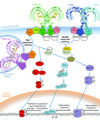Toll-like receptor 4 in CNS pathologies
- PMID: 20402965
- PMCID: PMC2909662
- DOI: 10.1111/j.1471-4159.2010.06736.x
Toll-like receptor 4 in CNS pathologies
Abstract
The responses of the brain to infection, ischemia and trauma share remarkable similarities. These and other conditions of the CNS coordinate an innate immune response marked by activation of microglia, the macrophage-like cells of the nervous system. An important contributor to microglial activation is toll-like receptor 4, a pathogen-associated molecular pattern receptor known to initiate an inflammatory cascade in response to various CNS stimuli. The present review traces new efforts to characterize and control toll-like receptor 4 in inflammatory etiologies of the nervous system.
Figures


References
-
- Nobel Lectures, Physiology or Medicine 1922–1941: Nobel lectures, including presentation speeches and laureates' biographies. Amsterdam: Elsevier Publishing Company; 1965.
-
- Akira S, Uematsu S, Takeuchi O. Pathogen recognition and innate immunity. Cell. 2006;124:783–801. - PubMed
-
- Akiyama H, Arai T, Kondo H, Tanno E, Haga C, Ikeda K. Cell mediators of inflammation in the Alzheimer disease brain. Alzheimer Dis Assoc Disord. 2000;14 Suppl 1:S47–S53. - PubMed
Publication types
MeSH terms
Substances
Grants and funding
LinkOut - more resources
Full Text Sources
Other Literature Sources

